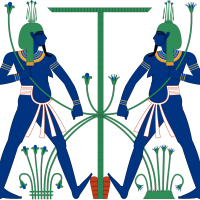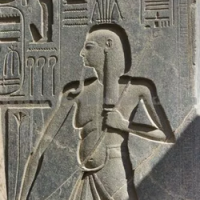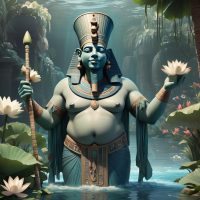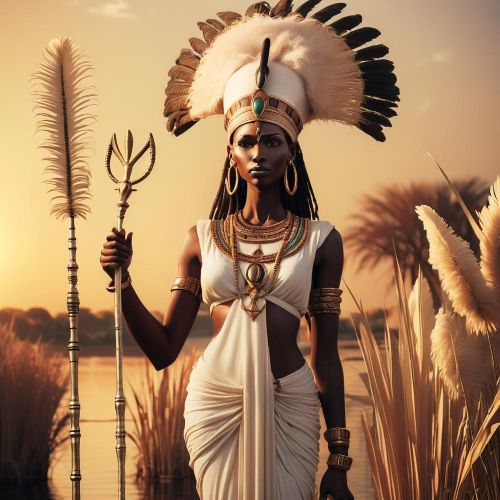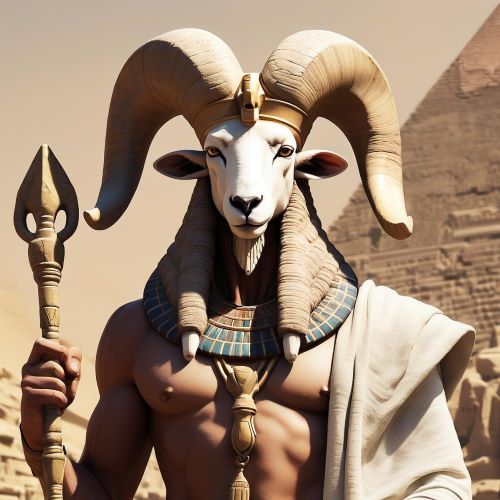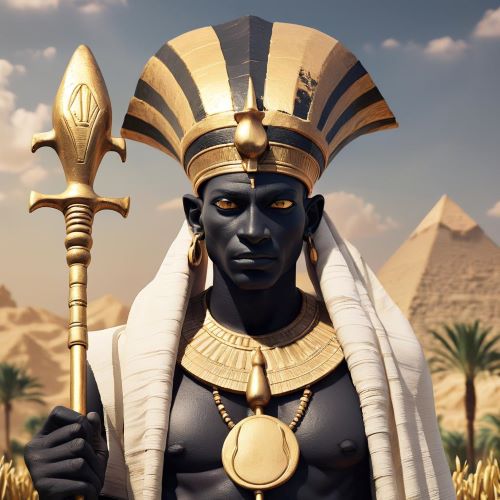Hapi : God of Nile Inundation
Listen
At a glance
| Description | |
|---|---|
| Origin | Egyptian Mythology |
| Classification | Gods |
| Family Members | N/A |
| Region | Egypt |
| Associated With | Nile, Fertility |
Hapi
Introduction
Hapi, known in ancient Egyptian as ḥꜥpj, was the divine personification of the Nile River’s annual flood, the lifeblood of Egypt. Revered as a god of fertility, abundance, and nourishment, Hapi embodied the natural cycles that sustained one of the world’s earliest civilizations. The inundation of the Nile was not merely a seasonal event but a sacred act of renewal, bringing nutrient-rich silt to Egypt’s farmlands and ensuring prosperity. Hapi’s blessings were invoked in hymns and temple rituals, reflecting his role as a benevolent and balancing force in nature. Unlike many deities who symbolized the sky, sun, or afterlife, Hapi represented the earth’s vitality and the steady rhythm that connected gods and humans through the river’s eternal flow.
Physical Traits
Hapi’s iconography is among the most distinctive in Egyptian art. He was typically portrayed as an androgynous, pot-bellied man with pendulous breasts—features symbolizing nourishment, fertility, and the life-giving nature of the Nile. His skin was often painted blue or green to evoke the waters and vegetation of Egypt’s riverbanks. This dual coloring visually linked him to both the abundance of the floods and the rebirth of the land that followed.
Hapi wore a short kilt or loincloth and often bore offerings of food, fish, or water jugs, highlighting his role as a provider. His headdress usually featured papyrus and lotus plants, symbols of Lower and Upper Egypt respectively, illustrating his function as a unifier of the Two Lands. In temple reliefs, he was sometimes depicted as twin figures tying papyrus and lotus stems together, an image that signified the harmonious joining of the nation’s northern and southern realms. Through this powerful symbolism, Hapi’s body itself became a map of Egypt’s geography and divine unity.
Family
Unlike many major Egyptian deities, Hapi was not a member of a royal divine family nor directly related to the solar gods. His associations were primarily cosmological and symbolic. Some traditions link him to Naunet, the female counterpart of Nun, the primordial waters from which creation emerged. Others describe his consorts as Nekhebet, the vulture goddess of Upper Egypt, and Wadjet, the cobra goddess of Lower Egypt, further reinforcing his unifying role.
Another myth names Meret, the goddess of rejoicing and song, as Hapi’s partner, emphasizing the joy and celebration that accompanied the Nile’s inundation. Hapi was also associated with Geb, the earth god, and Neper, the god of grain, both deities connected to fertility and sustenance. Though he lacked an elaborate genealogy, Hapi’s presence in Egyptian theology was essential. He stood as a cosmic intermediary between gods and mortals, ensuring the continued fertility of the land that kept Egypt alive.
Other names
Hapi was known by several names and epithets that reflected his regional manifestations and divine functions. His name is sometimes transliterated as Hapy, Hep, or Hap. In his dual form, he appeared as Hap-Meht (Hapi of Lower Egypt) and Hap-Reset (Hapi of Upper Egypt). Each version carried specific symbols, the papyrus for the north and the lotus for the south representing the two halves of the Nile’s domain.
He was often called “Lord of the River Bringing Vegetation,” “Father of the Gods,” and “Lord of the Fish and Birds of the Marshes.” These titles emphasized his mastery over Egypt’s ecosystem and his nurturing connection to all forms of life. Hymns dedicated to Hapi praised him as “He Who Makes the Land Green,” a poetic tribute to his power to transform barren deserts into fertile fields. While the Greeks later equated him loosely with river gods such as Nilus, Hapi remained uniquely Egyptian in spirit—an embodiment of life, fertility, and divine equilibrium.
Powers and Abilities
Hapi’s greatest power was his control over the Nile’s annual inundation. This flood, occurring between June and September, determined the success or failure of Egypt’s agricultural year. Too little water led to famine, while excessive flooding destroyed homes and crops. The Egyptians saw Hapi as the divine regulator of this delicate balance. His “arrival” each year was celebrated with songs, offerings, and processions thanking him for the life he bestowed upon the land.
He was not merely a river god but a cosmic force ensuring harmony between natural cycles and human civilization. The priests at Elephantine Island, where one of his main cult centers was located, carefully monitored the Nile’s rise using the nilometer, a sacred measuring device. Rituals conducted there sought to guarantee a steady and beneficial flood. In hymns, Hapi was praised as “He Who Fills the Granaries,” a reminder of how completely Egypt’s prosperity depended on his favor.
Hapi also symbolized political unity, as the Nile’s continuous flow linked the distant regions of Upper and Lower Egypt. His power thus extended beyond the natural world, representing order, continuity, and the divine rhythm that underpinned Egyptian cosmology. Through his waters, life was renewed, and the gods’ blessings made manifest on earth.
Modern Day Influence
Although the worship of Hapi declined with the end of ancient Egyptian religion, his influence persists in cultural, academic, and symbolic contexts. Egyptologists and historians continue to study Hapi’s role to understand how the Nile’s cycles shaped Egypt’s economy, architecture, and spirituality. The Nilometer and related Hapi rituals offer valuable insight into early water management systems centuries ahead of their time.
In art and literature, Hapi’s imagery remains a compelling symbol of balance and abundance. Modern Egyptian identity continues to draw from Nile symbolism, with the river still regarded as the nation’s lifeblood. In environmental discourse, Hapi is often referenced as a mythic representation of sustainable coexistence with nature, a reminder of how ancient civilizations revered ecological balance.
Hapi also occasionally appears in contemporary media, such as video games, documentaries, and artistic recreations of Egyptian mythology. He is often depicted as a serene, water-bound figure surrounded by flora and aquatic life, embodying calm power and nurturing energy. In New Age spirituality and neopagan movements, Hapi has been reimagined as a deity of water and fertility, invoked in rituals honoring rivers, rainfall, and environmental harmony.
While the modern acronym “HAPI” is sometimes associated with unrelated terms such as “Hospital-Acquired Pressure Injuries,” the ancient god’s legacy remains distinct and enduring. Hapi continues to symbolize the eternal connection between water, fertility, and the flourishing of life, a message that resonates profoundly in today’s world of environmental change.
Related Images
Source
Allen, J. P. (2014). Middle Egyptian: An Introduction to the Language and Culture of Hieroglyphs (3rd ed.). Cambridge University Press.
Bard, K. A. (2015). An Introduction to the Archaeology of Ancient Egypt (2nd ed.). Wiley Blackwell.
Hart, G. (2005). The Routledge Dictionary of Egyptian Gods and Goddesses (2nd ed.). Routledge.
Wilkinson, R. H. (2003). The Complete Gods and Goddesses of Ancient Egypt. Thames & Hudson.
“Hapi (Nile god).” (n.d.). In Wikipedia. Retrieved October 15, 2025, from https://en.wikipedia.org/wiki/Hapi_(Nile_god)[1]
“Hapi.” (n.d.). Britannica. Retrieved October 15, 2025, from https://www.britannica.com/topic/Hapi
“Hapi.” (n.d.). Ancient Egypt Online. Retrieved October 15, 2025, from https://ancientegyptonline.co.uk/hapi/
“Hapi (Nile god).” (n.d.). Simple English Wikipedia. Retrieved October 15, 2025, from https://simple.wikipedia.org/wiki/Hapi_(Nile_god)[5]
Frequently Asked Questions
What is lorem Ipsum?
I am text block. Click edit button to change this text. Lorem ipsum dolor sit amet, consectetur adipiscing elit. Ut elit tellus, luctus nec ullamcorper mattis, pulvinar dapibus leo.
What is lorem Ipsum?
I am text block. Click edit button to change this text. Lorem ipsum dolor sit amet, consectetur adipiscing elit. Ut elit tellus, luctus nec ullamcorper mattis, pulvinar dapibus leo.
What is lorem Ipsum?
I am text block. Click edit button to change this text. Lorem ipsum dolor sit amet, consectetur adipiscing elit. Ut elit tellus, luctus nec ullamcorper mattis, pulvinar dapibus leo.
What is lorem Ipsum?
I am text block. Click edit button to change this text. Lorem ipsum dolor sit amet, consectetur adipiscing elit. Ut elit tellus, luctus nec ullamcorper mattis, pulvinar dapibus leo.
What is lorem Ipsum?
I am text block. Click edit button to change this text. Lorem ipsum dolor sit amet, consectetur adipiscing elit. Ut elit tellus, luctus nec ullamcorper mattis, pulvinar dapibus leo.


